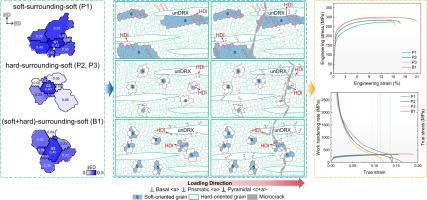Unveiling the role of DRXed grain orientation configuration in the deformation behavior of Mg alloys with bimodal grain structures
IF 14.3
1区 材料科学
Q1 MATERIALS SCIENCE, MULTIDISCIPLINARY
引用次数: 0
Abstract
Bimodal magnesium (Mg) alloys exhibit a favorable strength-ductility synergy through the interaction between dynamically recrystallized (DRXed) and unDRXed regions. However, the influence of orientation configurations within DRXed regions on the deformation behavior remains insufficiently understood. In this study, four bimodal AZ31 samples with comparable DRXed grain sizes and fractions but distinct grain orientation configurations were fabricated via hot extrusion. The global and local orientation configurations of soft-oriented DRXed grains (basal Schmid factor ˃ 0.3) were quantitatively assessed. A soft-surrounding-soft configuration facilitated early basal slip and enhanced ductility but led to pronounced plastic incompatibility and low yield strength (YS). A hard-surrounding-soft configuration increased but limited ductility due to poor slip transfer. In contrast, the B1 sample exhibited a (soft+hard)-surrounding-soft configuration that moderated stress gradients and enhanced crack resistance, achieving the best strength-ductility combination. These findings highlight the critical role of multiscale orientation configurations within DRXed regions in controlling deformation mechanisms and provide guidance for designing high-performance bimodal Mg alloys.

揭示了DRXed晶粒取向构型在具有双峰晶粒组织的镁合金变形行为中的作用
双峰态镁合金通过动态再结晶区和动态再结晶区之间的相互作用,表现出良好的强度-塑性协同效应。然而,在DRXed区域内取向配置对变形行为的影响仍然没有得到充分的了解。在本研究中,通过热挤压法制备了四种具有相似DRXed晶粒尺寸和组分但晶粒取向构型不同的双峰AZ31样品。定量评价了软取向DRXed晶粒的全局和局部取向构型(基础施密德因子≤0.3)。软包围软结构有利于早期基底滑移和增强延性,但导致明显的塑性不相容和低屈服强度(YS)。硬包软结构增加了延展性,但由于滑移传递不良而限制了延展性。相比之下,B1试样呈现出(软+硬)-包围-软的形态,缓和了应力梯度,增强了抗裂性,实现了最佳的强度-塑性组合。这些发现强调了DRXed区域内多尺度取向配置在控制变形机制中的关键作用,并为设计高性能双峰镁合金提供了指导。
本文章由计算机程序翻译,如有差异,请以英文原文为准。
求助全文
约1分钟内获得全文
求助全文
来源期刊

Journal of Materials Science & Technology
工程技术-材料科学:综合
CiteScore
20.00
自引率
11.00%
发文量
995
审稿时长
13 days
期刊介绍:
Journal of Materials Science & Technology strives to promote global collaboration in the field of materials science and technology. It primarily publishes original research papers, invited review articles, letters, research notes, and summaries of scientific achievements. The journal covers a wide range of materials science and technology topics, including metallic materials, inorganic nonmetallic materials, and composite materials.
 求助内容:
求助内容: 应助结果提醒方式:
应助结果提醒方式:


